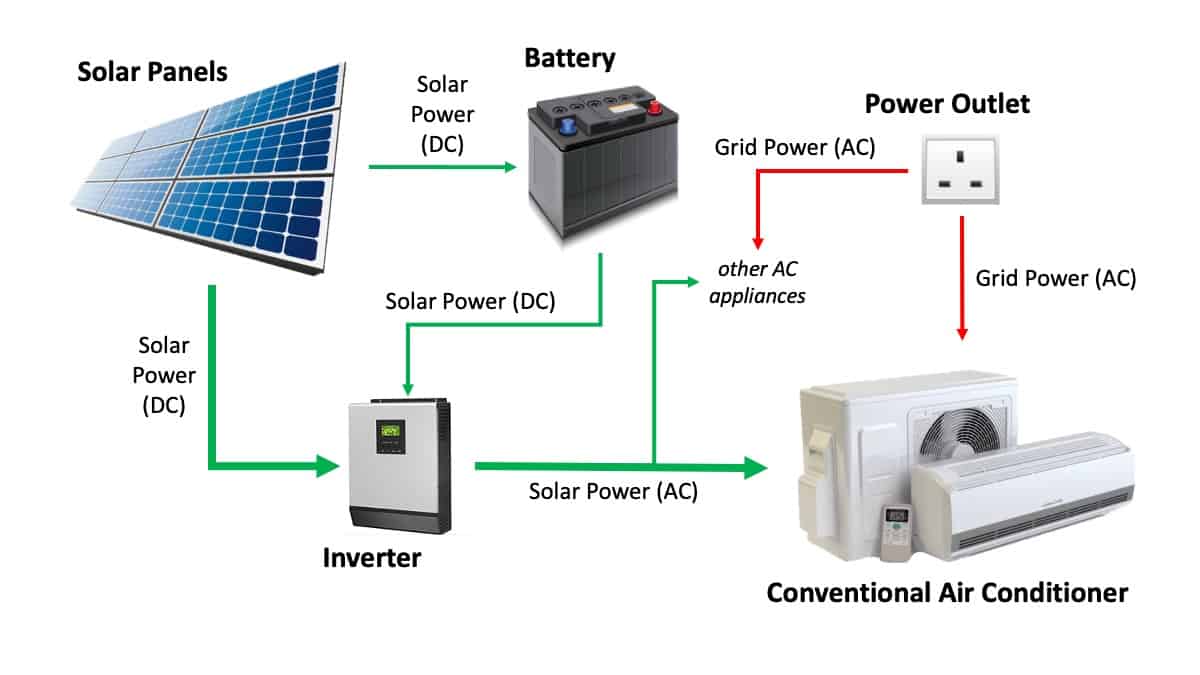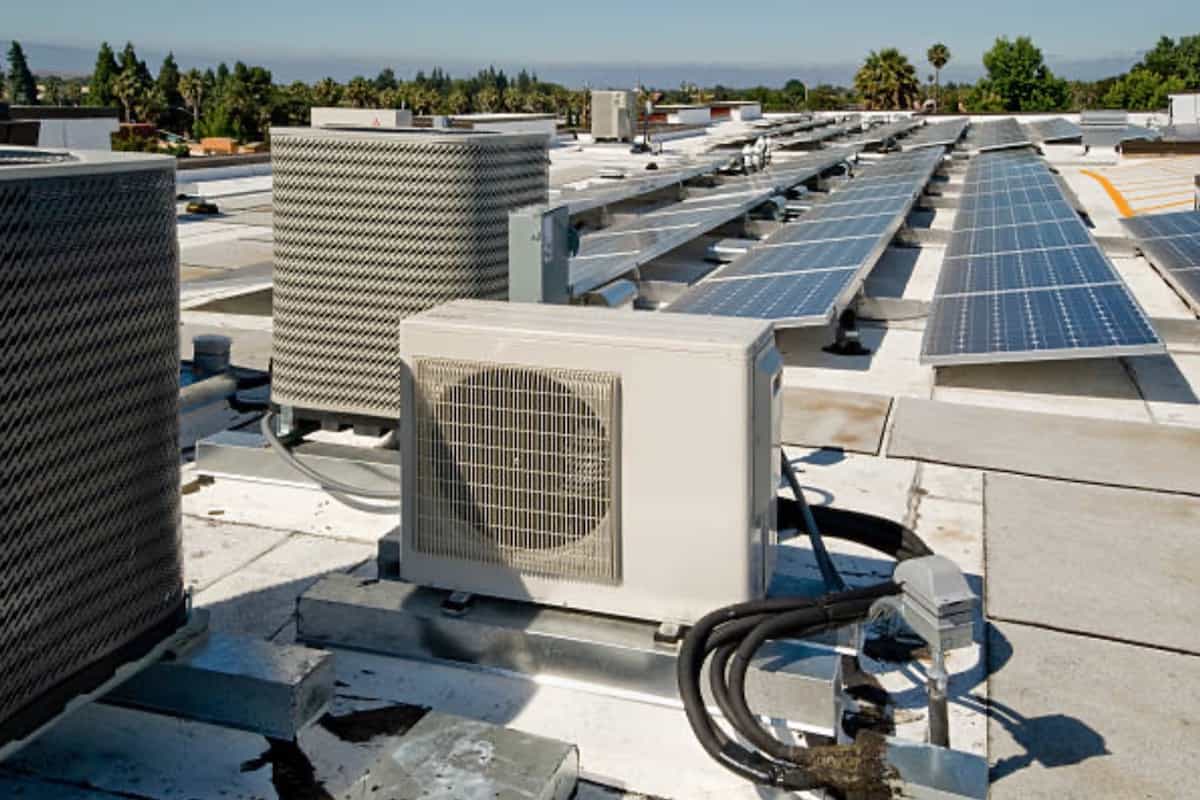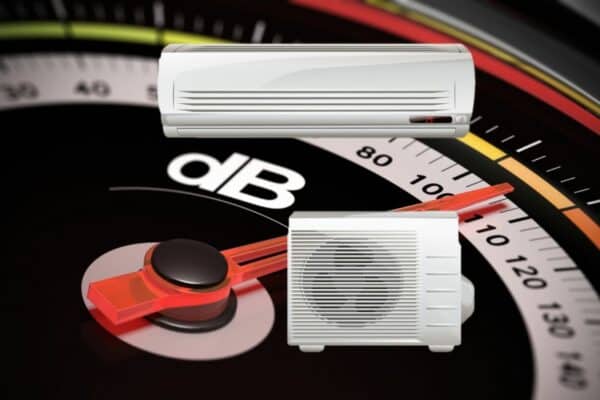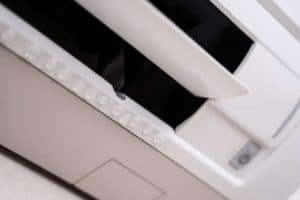How Solar Air Conditioners Work? (Hybrid vs Pure Solar)
Solar air conditioners consume significantly lesser power than conventional air conditioners. However, many people want to understand how solar air conditioners work before they proceed to buy one. So, I did some research on solar air conditioners.
Generally, there are two types of solar air conditioners; a) hybrid solar air conditioners and b) pure solar air conditioners. Hybrid solar air conditioners partially replace their power from the grid with the power generated by their solar panels to reduce the electricity cost. Meanwhile, pure solar air conditioners only use the power generated by their solar panels to operate during the day while charging their batteries for night use, resulting in zero electricity cost.
More and more people are getting into solar air conditioners. However, it is important to use the right type of solar air conditioner in order to yield an attractive return on investment.
Solar Air Conditioners Working Principle
Although there are other types of solar air conditioners in the market, hybrid solar air conditioners and pure solar air conditioners are the two most common types of solar air conditioners.
Hybrid solar air conditioners are sometimes known as ACDC solar air conditioners. On the other hand, pure solar air conditioners are also known as DC air conditioners or 100% solar air conditioners.
The compressor, inverter drive, fan motors and other components of solar air conditioners are powered by direct-current (DC) instead of alternating-current (AC) that power conventional air conditioners.
Some solar air conditioners don’t have DC-powered components. Instead, they are modified conventional air conditioners that utilize an inverter to convert the DC power from solar panels to AC power for operation.
Such modified solar air conditioners are usually inefficient because DC-powered components generally consume less power than AC-powered components.
Hybrid Solar Air Conditioners
A hybrid solar air conditioner has a DC air conditioner that connects to a few solar panels and a power outlet. In countries like Malaysia and Singapore, a 9000 BTU DC air conditioner requires about 800W of solar power or around 4 pieces of 200W solar panels.
Hybrid solar air conditioners are configured such that the primary source of power is from the solar panels while the power from the grid serves as a backup. Many hybrid solar air conditioners nowadays don’t require a separate inverter to convert the grid power from AC to DC.

Hybrid solar air conditioners are more suitable for daytime use as they don’t have batteries to store solar power for night use. With hybrid solar air conditioners, about 70% of the electricity cost can be saved depending on location.
However, during cloudy days, the DC air conditioner may draw power from the grid due to insufficient power is generated from the solar panels. Besides, some hybrid solar air conditioners may reduce cooling power in order to stay 100% on solar power for as long as possible.
Hybrid solar air conditioners are more practical for commercial buildings because they don’t go offline when there is no solar power. Instead, they simply use the power from the grid just like a normal air conditioner.
With hybrid solar air conditioners, the electricity cost can be reduced significantly because the majority of the power used by the air conditioners is free energy from the solar panels.
Pure Solar Air Conditioners
A pure solar air conditioner has a DC air conditioner that connects to a few solar panels and batteries. Unlike hybrid solar air conditioners, pure solar air conditioners usually have one or two more solar panels.
As for the batteries, it is depending on how long the DC air conditioners need to run without the power from the solar panels. Nevertheless, it is common to have a 500Ah battery attached to a 9000 BTU pure solar air conditioner.

Pure solar air conditioners are also known as off-grid air conditioners. As the name suggests, they can be used at places without the power grid. Pure solar air conditioners are 100% solar-powered.
During the day, solar panels generate power to run the DC air conditioner. Because there are extra solar panels, some of the extra power generated by the solar panels goes into charging the battery. At night, the DC air conditioner draws power from the battery.
However, during cloudy or rainy days, the solar panels may not have sufficient power to run the DC air conditioner, let alone charge the battery. In this case, there will be no cooling/heating during the day and even at night.
Nevertheless, pure solar air conditioners are more suitable for homes because most homes use the air conditioner at night. So, the battery can be charged to the fullest and operate the air conditioner throughout the night.
Conventional Air Conditioners with Solar Inverter
Now that we know how hybrid solar air conditioners and pure solar air conditioners work, let’s take a look at how the “old way” or conventional air conditioners with a solar inverter work.
Previously, people hook a conventional air conditioner (AC powered) to a solar inverter that is connected to a battery and a few solar panels. By doing so, they don’t need to upgrade their air conditioners.

Since the air conditioner is AC-powered, the system requires an inverter that converts the DC power generated by the solar panels and discharged by the battery to AC power to run the air conditioner.
With such a configuration, the return on investment is theoretically better. In addition, the solar system can also provide “free energy” to other appliances in the house which further reduces the overall electricity cost.
However, this configuration involves much more work than simply using a DC air conditioner (either hybrid or pure). Depending on the labor cost, wires length and local authority approval time, this configuration can sometimes be more expensive.
Naturally, DC air conditioners are more energy-efficient than AC air conditioners. Besides, having an additional inverter result in more energy losses. Hence, this type of solar air conditioner often has a lower efficiency than hybrid solar air conditioners and pure solar air conditioners.
Final Thought
Solar air conditioners are generally too expensive for most people. However, the cost is declining. In my opinion, using a few solar panels and several small batteries for a DC air conditioner may not be the ultimate solution for off-grid cooling/heating.
Instead, transforming the entire house into solar-powered with large batteries may be the ultimate solution not just for cooling/heating, but also for other appliances. For instance, Tesla solar panels with powerwall. With the entire house powered by solar, high efficient DC air conditioners will be extremely valuable.
Nonetheless, until then, hybrid solar air conditioners, pure solar air conditioners and perhaps, conventional solar air conditioners are the path to sustainable energy.
To learn more about HVAC, purchase and download the HVAC Begin (eBook).
If you have anything to add (or ask) about this topic, leave a comment down below!









